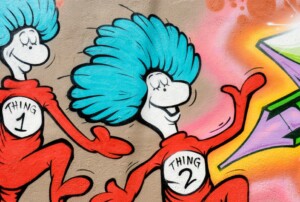
Suddenly, I noticed it was everywhere. I’m not just talking about the ads that creepily follow us all around the internet. It’s one of those situations where you talk about something and it becomes the focus of your intention. Maybe you have a small epiphany or revelation about the idea which really puts it front of mind. Next thing you know, you just start noticing people talking about it or articles written about it. Then you say to yourself, “I never noticed how popular this is.”
In my case, I’m talking about the art of storytelling. We all know that a good story can captivate and motivate people. They connect more with it emotionally. But depending on where you are in your life you can hear that and say, ‘yeah cool, makes sense,” and that’s it, you think nothing of it. Or, you might say, “actually, this is really interesting. Let me dig into that more.”
Sometimes you think nothing of it and then a few years later you have a fresh perspective and it hits you much differently and you have a small revelation (Usually triggered by a life experience) about the idea and say, “oh shit, now I really get it.” The information was just as profound before but you just didn’t connect with it. Many times the insight sounds basic and logical so you overlook it a bit. But what seems simple on the surface does not mean there isn’t complexity when you dig a litter deeper.
Our job as Change Creators who want to help others, by teaching what we know, is to help you save time and get to important conclusions faster.
As a media company with a digital magazine app, we are always telling stories. We use information to inform people, educate and make a difference in the world. But these insights are relevant and important to all people, especially in today’s evolving digital landscape.
Since my small revelation, I have personally interviewed several incredible people to help us all better understand this art of communication and storytelling, so we can all learn how to master it faster.
To avoid information overload, I’ll start with 3 important insights you should think deeply about, especially if you want your business to succeed.
1 – Be Intentional and Don’t Get High on Your Own Supply
Here’s a quick clip where I mention how stories and personal experience made Salvador Dali great. This ties into my comment about seeing story everywhere now and it’s a segway into the next video segment from Jay Shetty.
[vc_video link=”https://www.youtube.com/watch?v=6uXyDLROqbY&feature=youtu.be”]
Jay Shetty is on a mission to make wisdom go viral and so far he has been very successful with over 2 billion views of his videos. What makes them so impactful? In our discussion, we explored that very topic and got a better understanding of how he thinks about storytelling.
[vc_video link=”https://www.youtube.com/watch?v=-xJBXG-6dpo&feature=youtu.be”]
Video Transcript
I have to give the credit for the art to my art teacher from when I was like, I guess in my teens, 11 to 18, I had one art teacher at school and always on my favorite subjects are in design. And whenever we do a piece of art, he does it like whether it was a painter I was terrible at painting was pretty good at graphics, I was terrible at fine too. But anytime we would draw something or put a collage together, or do something graphically, the number one question you need to go to me is, why did you do that? Like, why is that color next to that color? Why is that item on top of that item? Why is that juxtapose next to that? Like his question will be like, why did you do that?
And if I didn’t have an answer, I get a low grade and he had an answer, even though it didn’t look visually as good I get a good grade because his whole point was a mountain, meaning it was always about
Are you meaningfully connecting our colors and designs and objects and the and visions? Or are you just doing it because it looks good?
And I think that’s a beautiful way of looking at storytelling. Are you trying to tell a story so that it looks good? Or are you trying to tell a story because it’s going to be meaningful to the viewer.
So the way I explained this is that there are two types of storytellers. There are two types of creators. Imagine a spectrum. Imagine one end of the spectrum and the other end and one of the one of the spectrum you have selfish creators, what I like to call selfish created. These are people who create simply for themselves, it’s the people who get high off their own supply, right?
It’s like you made a video or you wrote a book just because you thought your idea was amazing, right? You think what you have to say, is so amazing that you make a video that you enjoy, and maybe a few of your friends tell you, it’s good. And maybe there’s a niche for you that you can grow into your selfish creator. You’re only making videos because you feel like making them for yourself.
That’s one end of the spectrum. Nothing wrong with that. No judgment. Just sharing how it works.
The other end of the scale, you have what I call sellout creators. So sellout creators only tell stories that they think people are going to love. They only tell stories that they think are going to go viral. They only focus on stuff that they think is going to get likes and what happens very, you may even get likes, but you won’t feel fulfilled inside you may even get followers and views you might not you probably will. But even if you did you still want to feel like you’ve made an impact or anything right? And that’s why when I talk about is being the best storytellers are selflessly self-aware, self-aware, self-less self-aware and selfless.
So what I mean by that is, the best storyteller has the deepest understanding of people’s pain and problems, because they’ve either lived through them themselves, or they have lived through them with others. And then their focus is on saying, how is the best way of communicating this and it may not be a video, it may be a written piece, it may be a whole book, it may be a speech, it doesn’t have to be the same format and then really figuring out how does this connect with people.
So I always say to people that I, I spent the last 12 years of my life sitting with people listening to their problems. When I was a monk, I used to coach people for free for no money for more hours in a day than that I could possibly do. And I would sit them and just-just discuss their problems and help them out of it. And that gave me a much stronger understanding of human behavior. So for me, storytelling is a deep understanding of human pain, human behavior, and then the most, most ideal format for communicating that
2 – How You Tell Your Story Can Make Or Break Your Business
What do you really need to consider when you think about your branding for an impact business? Mona Amodeo is a branding expert in the impact space and we had a chance to connect with her to discuss. Not only does she emphasize the importance of story for branding but she breaks it down in a way that helps us all understand how the moving parts come together.
This all comes together to prove out that story is the foundation of successful marketing. We call it StoryMarketing!
Is your brand attracting the right audience? Do people want to get behind your cause? What do people think about your brand? what’s your reputation?
[vc_video link=”https://www.youtube.com/watch?v=Uqp-Vw1iJP0&feature=youtu.be”]
Video Transcript
Adam G. Force
What’s the first step in understanding…well is my brand…Like…Is it saying the right thing to people? Is it attracting the right people? What are the like, I guess, preliminary or early stepping stones and thoughts around branding that needs to be considered for somebody?
Mona Amodeo
Well, I think if we think in terms of this, if we just kind of put if you can imagine three circles, interconnected circles and circles being first your business plan, what is it you’re trying to do? What are your goals? What are your dreams? What are your hopes?
The second circle, in that that’s kind of your intentions, right? The second circle comes to this idea of the brand, which really defines why you matter. I mean, every organization has to answer this question, Who are you and watch it, I care. And ultimately, your success or failure will depend on your ability to do that branding helps you shape that story. That sense of this is who we are, this is what we do. This is what we believe. And most importantly, this is what we can do for you in a way that’s different unique than other people.
So that second piece branding is that middle piece between your intentions of your business plan and your actual building the tribe I call it of people who really want to be connected.
You know, ultimately, though, Adam, what we’re really trying to do here is we’re trying to use branding as a vehicle for creating a reputation.
3 – Stories Create Chemical Reactions in the Brain
I personally made this video to stress a really important point. As a human behavior nerd, I loved learning about the chemical reactions in the brain because what it revealed is that external conditions (story) create a reaction that shapes someone’s behavior, how they respond. This is the most important part of marketing which makes this lesson 100% essential to master.
[vc_video link=”https://www.youtube.com/watch?v=G8BeaVkNb70″]
Video Transcript
I recently came across a fascinating experiment. And it has two parts. One they wanted to understand does telling a story over video has the same impact on people as telling a story in person. The answer is yes. Two, they wanted to understand people’s reactions to the video. So they created two stories on video. One was about a little boy and his father, the little boy has cancer. The father is very emotional about it.
The second story was about the same little boy and the father. And they’re just walking through the zoo. Okay, so in the first video, people had a massive neurological change. And this is really important to understand because that neurological change is a reaction to the story. And when that neurological change happens, the human behavior changes, for example, you might be more willing to donate to a charity, the second video, people a dream halfway through, they were not hooked, they were not engaged. There was no emotional factor that pulled them in. And it’s that emotional factor that they find that creates a chemical in the brain called oxytocin. And that drives empathy. It drives people to be more cooperative.
So when you’re struggling as an entrepreneur, and you’re not being heard, especially by the most important people, the one percenters of your audience, I would highly, highly recommend starting to take more notice about human behavior.
Because whether you’re telling a story to get people to love your brand, or you’re trying to sell a product or get somebody on your team, or even get your wife to go out to a certain restaurant, you’re always selling and you can sell better when you know how to communicate because you understand human behavior. When you understand that human behavior. You could shape your story to be more effective.






